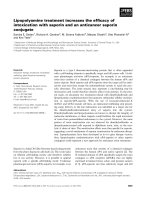ILLUSTRATIONS OF THE NATURAL ORDERS OF PLANTS WITH GROUPS AND DESCRIPTIONS V1, TWINING 1868
Bạn đang xem bản rút gọn của tài liệu. Xem và tải ngay bản đầy đủ của tài liệu tại đây (21.12 MB, 488 trang )
ILLUSTRATIONS
m
OF THK
NATURAL ORDERS OF PLANTS
GROUPS AND DESCRIPTIONS
BT
ELIZABETH TWINING.
"I
REDUCED FROM THE ORIGINAL FOLIO EDITION.
/(fP
VOL.
I.
LONDON:
SAMPSON LOW,
CROWN
SON,
BUILDINGS,
188
AND MAKSTON,
FLEET STREET.
1868.
(The Right
uj Ti-vuilatioH
u
nftrvcd by Ihc .iulUor.)
;
580
V,
1
INTRODUCTION.
J
——
^
Of
*
all
the varied objects of creation there
and delight
affords so ranch gratification
bining so
many
is,
to
probably, no portion that
mankind
various qualities of utility and beauty, and being as
they are so widely spread abroad in the world,
valleys,
Com-
as plants.
and the mountains
;
in
— over
the
plains, the
depths of the earth, and in the
the
waters of the ocean, the lakes, and the rivers, and every pond and pool
in the hottest regions of the tropics,
and extending even
to the frozen
lands of the Arctic zone, they claim attention everywhere, and in all
.
^
times, in a pre-eminent degree.
From
when the simple and abundant
daisy yields
recreations, until the close of
when
^ there
vj
^
is
life,
the earliest years of childhood,
one of the most valued
flowers are planted on the grave,
no period when some of the countless variety of plants do not
way
minister in some
and ancient authority
to
our comfort and enjoyment.
for the study of plants.
We
There
is
read that he to
high
whom
^ was given " wisdom and understanding exceeding much, and largeness
o of heart,"
ci east
<\
whose " wisdom excelled the wisdom of
country, and
" the cedar-tree that
v^^ut of the
wall."
the wisdom of Egypt,"
all
is
all
— he
the children of the
spake of trees, from
in Lebanon, even unto the hyssop that springetli
It is interesting to think of this branch of
knowledge
-< as of one which contributed to spread the fame of Solomon " in
nations round about," so that " there came of
all
all
people to hear his
r^ wisdom."
numerous proofs of the value of a knowledge of
plants in all ages of the world.
It is now 250 years since the good
old Grerard completed his famous " Herbal " in this country, and declared
There
^
^ he
are, indeed,
could find no greater delight than to behold the earth
with plants,
—a
delight great to the
apparelled
outer senses, but greater
16652
still
to
INTRODUCTION.
ii
mind enriched with the knowledge of these visible things, " setting
forth to us the invisible and admirable workmanship of Almighty God."
the
JMany works have already been prepared
nature of plants,
to
mark
—
manner
their
But
in simple,
to the
and
it is
hoped these
fication to those
to
in
of plants,
descriptions,
may add something
If they can increase grati-
possess beautiful gardens, or delight in searching
out the native plants of our fields and roads
awaken
combined with
be derived from plants.
who
in every part,
when faded and gone during the decay
illustrations,
as far as possible untechnical language,
enjoyment
imderstanding the
in
arrangement
of growth, to ascertain their various properties,
or to recall their beautiful forms
of winter.
aid
to
to explain their wonderful
or if they should be able to
;
any miud an interest in the study of the nature and properties
my
design will be
fulfilled,
and a humble, but very earnest
desire accomplished.
The groups
are intended to show in one view some of the principal
plants composing the respective tribes, arranged as
modern
science has
The system
found to be in accordance with structure and properties.
of
De CandoUe
is
that followed, with only slight exceptions.
In every
Order that contains British plants English species are selected as examples,
By
but combined with others from foreign countries.
native plants in groups with foreigners,
of the nature of our Flora, and
with that of other countries.
we acquire
the character
Tliis is
the
first
it
a
thus placing our
more
correct idea
when compared
has
work which has thus done
due honour to our British plants by connecting with others, and placing
them whenever
new method
The
possible at the head of the Order to be illustrated.
plants into Orders, according to the structure
of classing
of the parts of fructification,
is
thought to be more
than the old system of Linnaeus
;
difificult to
the student
but having groups brought before us,
One
united with descriptions, renders the subject easy and agreeable.
very interesting point
thus gained,
is
— that
is,
a ready perception of the
geographical distribution of any particular tribe.
Also,
what proportion
our British Flora bears, both in quantity and quality, to the whole range
of the Natural Orders
abundance
;
:
how we have some
tribes in their full vigour
of others, only a few species, scattered, as it were,
geographical limits of the tribe.
in our temperate clime
exclusively to the
;
for
tropics,
Of
others,
no specimen
some of the groups
and some
to
will
will be
and
on the
found
be seen to belong
the cooler regions.
By
thus
connecting our own Flora with a general view of the Orders to which
the
plants
we
possess
belong, a higher interest
may
be given to the
INTRODUCTION.
many
examination of
may be
lowly flowers of our
named from
Tlie
fields.
considered as a perfect type of
culaceoe,"
Ul
common
numerous
tliat
tribe
buttercup
" Eanun-
the genus, and abounding chiefly in the northern
The study of Euphorbiacese, the Spurge tribe, in
show either small herbaceous weeds in gardens, or a
of rather larger size, but not more pleasing aspect,
countries of Europe.
this
country, will
few other species,
in
woods and hedges
but, on examination, one chief character of the
;
Order will be observed, namely, an abundant milky juice of extreme
The very curious arrangement of the
acridity.
parts of the flower
be perceived, also, as well in these as in the larger species
on the mountains of Northern India, or at the base
tropical America, or
of the
Peak
may
which grow in
of Teneriffe
some of which attain a gigantic
;
size, rising
in upright, angular columns, or with variously branched stems, beset
These have, indeed, a very different aspect from
with strong spines.
that of our small weeds of this tribe, but the essential characters are the
Among
same.
those tribes of which
we have
specimens in
the finest
the British isles
may
these
a vigorous growth in the temperate climate of this
attain
all
be noticed the oak, elm, ash, and willow-trees
:
The oaks of England are not surpassed in any other part
of the world.
The ash of the Isle of Wight rivals that of North America.
Of some tribes we possess only a few species, which are beyond the
boundaries of the chief mass of the group,
as in the Mallow tribe, which
country.
—
belongs principally to the tropics, extending a few small species into
our temperate region.
we have one genus in Britain,
Germany, and discover the main centre of the
In other
a few more in France or
tribes,
group in some other part of the Continent.
Helianthemum
is
the only British example.
and Switzerland, and the chief mass of the
There are many
we
them out
follow
large
tribes of
trees
belonging
the tribe.
to
all
small herbs
Of the Umbelliferous
tenuissimum the
is
an evergreen shrub,
coast of Barbary
;
tribe
smallest.
is
and Portugal.
we
often
perceive shrubs or
may be
Perhaps the same genus
in the East Indies one is
The English
species
an evergreen shrub.
we have numerous herbs only
;
Bupleurum
In the south of France Bupleurum fruticosum
five or six feet
high
a hoary evergreen of
;
Bupleurum canescens on the
Of the
still larger growth.
extensive tribe of composite plants forty-five genera are found in Britain,
many
of
them very
;
found in Grermany
tribe is in Spain
expanded into shrubby species in warmer regions.
of flax are
is
which we possess only small herbs, but when
hotter countries
into
This occurs in Cistacese
Cistus
plentifully, as the Daisy, Tliistle
and others
;
but
all
INTRODUCTION.
IV
herbaceous, and near!}"
The great Scotch
of low growth.
all
of the finest of the tribe,
is
seldom more than
one
Thistle,
five or six feet in height.
Some, however, of the British genera may be found existing
other
in
countries, and there developed in very different specific forms, as shrubs
Sonchus, of very tender, succulent nature here, affording food
or trees.
known
Some
for rabbits, is
green shrubs.
composite
Madeira and the Canaries
form of ever-
we have of the vast
and Spartium, the Broom, are of
the various native species
tribe, onl}' Ulex, the P^urze,
Proceeding towards the south of France, we meet with
a shrubby nature.
the Laburnum, and other trees of considerable
size.
ther into tropical regions, this important tribe
is
trees, of varied utility
is
in the
of the largest trees of St. Helena belong to this
Among
tribe.
Leguminous
in
and beauty.
Advancing
fur-
still
found in shrubs and lofty
Amherstia nobilis, of the East Indies,
a large tree bearing magnificent drooping branches of scarlet flowers,
said to be
im surpassed in the vegetable world.
The Hymenea of
Brazil
has been found to measure eighty -five feet around the base of the stem
is
2000
said to live to
only
Of the
years.
grass tribe,
;
it
we have lowly specimens
our native species incline more to the northern than the southern
:
types.
Poa, our
and Melville
meadow
Island.
grass, stretches to the icy regions of Spitsbergen
Other of our grasses are found also to the south
;
and
these frequently in lofty situations, as on the Alps, near the limits of per-
petual snow
is
;
on the Andes, and on the Himalayas.
common
the
reed, our largest species of this tribe
about the mouth of the Thames,
grasses of the South.
it
gives
Arundo Donax,
of
Arundo Phragmites,
in the
;
deep ditches
an idea of the more gigantic
North Africa, advances into the
South of Europe, and gives a clear indication of the more highly developed
tropical species.
we perceive
But there
is
one striking character of this tribe which
as distinctly in this country as
anywhere
:
the peculiar pro-
perty of spreading over wide spaces of ground with scarcely any intermixture
of other plants, can nowhere be better observed than in our
lawns.
meadows and
In the Tropics, large grasses grow separately, like other plants,
are of greater size
and height, and in some instances have wider leaves
than any of the species belonging to the temperate zone, and assume partly
the appearance of trees.
In examining other tribes, we find the same genera or species widely
spread in distant countries, and retaining the same form and appearance,
but growing in different situations, where there
able
for
their
growth.
may
be a climate favour-
Vaccinium Myrtillus, the Bilberry,
shrubby plant, spreading over a wild ground
;
it
is
abounds in various
a low
jjarts
INTRODUCTION.
V
of Britain, eitlier on heatlis, or on rocks of no great elevation, as those of
Tunbridge Wells
;
or on a turfy soil in the northern counties of England,
and the moors of the Scotch Highlands.
to
low rocks or moors
Alps
it is
;
In Switzerland
on the higher part of the Simplon Pass
;
and
sides,
autumn
in
it is
not confined
found on the turfy heights of the
also to he
covers
it
tlie
ground on
by
gives a bright colouring to the scene
its
all
red
leaves.
In the Saxifrage
It
is
all
position according to the climate.
which
is
in
is
abundant on the highest
Northern countries, merely varied in
For example
hills
:
Saxifraga oppositifolia,
of Wales, Yorkshire, or Scotland,
found also in Switzerland, Grermany, and France
still loftier
form or situation.
tribe, there is very little diversity of
extensively scattered over
than those of Britain.
localities
but in those countries,
;
may be
It
seen on the
northern slopes of the Pyrenees, on the mountains of Moravia and Bohemia,
and on the Grimsel, Ghemmi, Kighi,
Grothard,
St.
and other Alps,
elevation sometimes approaching the limit of perpetual snow.
plant
is also
There
it
This
to be traced as far north as Melville Island, in 75° of
finds a sufficiently cold temperature
monotony of which
it
enlivens with
earliest arrival of spring.
its
The budding
at
an
little
N.
lat.
on the level plain, the dreaiy
bright purple flowers, on the
of this small Saxifrage was one of
the welcome indications of spring that gladdened the hearts of Captain
Parry and
his crew, after their
ice-bound winter in the Polar regions.
The Juniper of our northern moors
is
another plant that
persed, and consequently inhabits very dissimilar localities.
it
northwards, we shall find
its
is
widely dis-
If
we
follow
low stunted form on the level plains of
Lapland, which are during a great portion of the year covered with snow.
If
we search
for it in hot countries, it will be
on the western slope of the Himalayas,
There
are,
found only on mountains, as
at 14,500 feet.
however, a few minute plants
among
the lower tribes, which
are not only entirely of the herbaceous class, but which, in whatever part
of the world
in
still
we discover them, inhabit similar
waters.
Callitriche verna, the
situations, floating always
Water Star- wort,
so plentiful in the
Lord Auckland's
ditches and ponds of England, has also been observed in
Isle, in
65° of
65° of N.
lat.,
S. lat.,
and in the Azores, in 38° of N.
lat.
In Iceland, in
our Callitriche autumnalis covers the ponds and ditches.
In these humble plants, we not unfrequently find a greater power of
adaptation to various climates and stations, and a more extensive dispersion over the globe, than in the higher tribes.
varied forms vegetation assumes, and in what
It is
remarkable what
strange situations
it is
found.
"
IM'llODUCTIUN.
vi
Deep in the coal-mines of Saxony, far from the liRhizomorpha subterranea, a small branching plant, on the limits of the
Fungus tribe, which possesses phosphorescent properties, and shines in the
dark with great brilliancy. Racodium cellare is a very singular substance
of the
with
Fungus kind,
its
that occasionally grows in cellars, filling every space
hanging masses of black
thin covering of
flat
Eocks which appear
fibres.
at a distance
on closer examination to be clothed with a
to be bare, are often perceived
Lichens, of various kinds, some of which adhere so
firmly as to be inseparable from
Some
it.
of the Conferva3 have been
found growing in boiling springs in Arabia, at the Cape of Good Hope,
and
Marchantia and Lycopodium were seen
in the Greysers of Iceland.
close to hot springs in the Island of
Amsterdam, in the Indian Ocean.
Several of these lowest tribes of plants are also capable of enduring ex-
treme
cold.
where
it
is
The Reindeer Lichen
covers extensive plains in Lapland,
buried under thick snows for
many months
without injury.
Protococcus nivalis, a minute plant on the verge of vegetable
noticed by Saussure, on the perpetual snow
first
surface with a red liue
:
it
was
consists of simple cells filled with a red fluid,
and has obtained the name of Red Snow, from
its
appearance, which at
much
It excited also
caused great perplexity.
first
life,
of the Alps, tinging the
surprise to Captain
Ross and his crew during their expedition to the Polar regions, where
was discovered reddening vast plains of snow and
Various kinds of Algae, or Sea-weeds, pervade both
water in every possible situation.
be scarcely perceptible to the
Some
naked eye
the Indian Ocean
of 1500 feet.
like a floating
:
salt
are so exceedingly
;
stem any land plant. Macrocystis pyrifera
it
ice.
and fresh
minute
as to
others far exceed in length of
is
a tropical genus, inhabiting
the slender stems are said to reach the enormous length
The Sargassum,
meadow on
or Grulf-weed,
the Atlantic Ocean,
extending from 25° to 36° of N.
water, others in deep seas.
lat.
Some
which Columbus met with,
is
often seen in large masses,
species flourish in shallow
Fucus vitifolius was brought up from a depth
of 190 feet, off the Coast of the Canaries, by
Humboldt and Bonpland, and
exhibited the peculiar property which sea-weeds possess of acquiring green
colour without the aid of light.
Truly " the earth
is full
of riches
Not only does the land bring
;
so is the great
and wide sea
forth abundantly every green herb
also
and
I
tree
after its kind, but the waters are also full of suitable vegetation, affording
food and shelter to the " things creeping innumerable " that dwell therein.
It is
remarkable that among those plants considered
useless,
are to
be
INTRODUCTION.
vii
found the most striking examples of beautiful form, brilliant colour, and
fragrant scent, as
as if thus to
is
and the Orchis
particularly the case in the Lily
remind us that they
are to be observed for
also are not to be disregarded
some good and wise purpose
that
;
tribes,
that they
;
we may admire
them for their excellent beauty, and examine their wonderful structure,
and perceive, thus more clearly, the omnipotence and the mercy of the
Creator, who knoweth whereof we are made, who seeth that our patli is
beset with many thorns, and that our spirits, as well as our bodies, are
liable to weariness,
service to
and need refreshment and cheering
Even the
pilgrimage.
man
;
so-called
useless plants
may
and though not offering any material
available for other
and higher purposes.
as
we
pass on our
have their allotted
uses,
may be made
They can perform a share
of the
great work of enlightening the mind, and refining the taste, and purifying
the heart for true and simple enjoyment.
lible
fails
man, who, even
in
of the intended end
sible to all
;
they are the
and
city
may derive
will readily
grow."
gifts of
;
our heavenly Father, accesforth
the weariest and weakest
the green herb and the lowly flowers
crowded
are no invention of fal-
The joyous can go gladly
His children.
path in the bright garden
way on
They
best plans for gratification or recreation, often
liis
;
on their sunny
may
rest
on their
and the busiest even in the
cheering delight from the humble window-garden,
pause on their course to " consider the
lilies
how they
CONTENTS OF PLATES.
VOLUME
I.
PAGE
1.
... Ranunculus
Delphinium cuitum.
RanunculacEj?':
Anemone
ac7-is.
Anemone
Japonica.
Trollius Europceus.
Clematis
coronaria.
Helleborus/ceft'rfe^s.
viticena.
2.
DlLLENiACE^E
Candollea
Dillenia scaZ>m?«.
Hibbeilia vombiiis.
cuneiformifi.
Hiljbertia j^cfhincumta.
3.
MagnoliacEjE
IMagnolia
...
Talauma
grandijiora.
Liriodendron
Candonii.
tmipiferum.
Anona squamosa.
4.
AnonacEjE
5.
MENiSPERMACEiE
.
.
Pmnlcenetii.
macrocarpus.
6.
BERBEiUDAGEiE
7.
FuMARlACK^
...
lateriflora.
Menispermum
virginicum.
Cocculus
Cocculus
Cissampelos Caaj^eba.
Cocculus patmatus.
Cissampelos Pareira.
Cissampelos iropaoiifoiia.
Epimedium
Berberis vulgaris.
Fumaria
capreoiata.
Didytra formosa.
8.
Guatteria
Menispemiuiu canadense.
Corydalis
Diphyllea cymosa.
aipinum.
Corydalis
Corydalis
mtea.
Nymph ea a2&a. '^ymphea jiygmea. Nuphar
Nymphea coerulea.
Xympheace.e
tuberosa.
Cashmmana.
/w^eo.
Xelumbiuni
speciosum.
9.
pAPAVERACEiE ... Papaver somniferum.
Meconopsis acmeatum.
10.
Sarraceniace^
11.
Cruciace^e
...
Papaver
Rhmas.
Glaucium
^arracen\?i purpurea.
Savracenia variolaris. Heliamphora
Brassica
Lunaria
oieracea.
Capparidace.e
...
Capparis
13.
Capparis
ncjairll.
Bixa Ormana.
BiXACE^E
14. PASSiFLORACEiE
...
ViOLACEiE
\\o\a
ITybanthus.
mtifoiium.
Cratoeva fragrans.
Cratoeva RoxCapparis ovata.
Physostemon.
Capparis jEgyptiaca.
Flacourtia i?amor«teA/.
Passiflora edmis.
Tacsonia moiiissima.
15.
Breynia.
Sodada decidua.
Polanisia chnidonii.
burghii.
Capparis
spinosa.
?!«/««*.
Nasturtium officinale.
Cheiranthus Cheirl.
biennis.
Erysimum Petrowshianum. Iberis gibraitarica.
Schizopetalon Wa/iheri.
Y &ivoca\\\s pyrenaica. Thlaspi
12.
mtcuin.
tricolor,
Alsodea
Passiflora racemosa.
Flacourtia inermis.
Passifiora maiiformis.
Sraeathmannia lavigata.
\io\a odorata.
Physipiliora.
Erpetion
?'en«/b?'ms.
Curynostylis
lonidium Ttoubou.
V*
CONTENTS OF PLATES.
X
PAoe
16.
Polygala chamcsbuxut.
Pdlyiiula cuvdifoUa.
... Polygala cuii/ari.s.
Securidaca tomentosa.
Mmaltia inirta.
^lundia spinosa.
Polygala
POLYGALACE.E
Trigonia.
crotolar hides.
Reseda
17. Resf.dace-E
Reseda
Zu^coZa.
18.
DaosERACEiE
Drosera rotundifolia.
Aldrovanda vesiculosa.
19.
OXALIDACE.E
Oxalis acetosella.
Za/ea.
Reseda
Dionea
o^/ora/a.
Byblis
muscipula.
Averrlioa
Oxalis florihunda.
liniflora.
Carambola.
Oxalis confertissimn.
20. PiTTOSPORACE.E
'
Billardiera
Pittosporutn Tohira.
...
Bursaria spinosa.
linearis.
Clieiranthera linearis.
Linmn
21. LinacEjE
Linum
usitatissimum.
Liniim africanum.
trigynum.
Radiol a millcgrana.
22.
ClSTACE^
cyprius.
Helianthemum
Heliantlieinum
formosum.
Cistui?
vulgare.
Helianthemum
23.
Malvace^
24.
canescens.
Malva moschata.
Malope
Trop^olacf.e
Gossypium herhaceum.
Hibiscus syriacus.
Abutilon striatum.
Hibiscus Mosa-sinensls.
trifida.
Tropajolum peregrinum. Tropfeolnm umhelTropteolum edule. Limnanthee Douglassii.
Tropfeoliim majus.
...
Helianthemum
poUfolium.
Helianthemum rhodanthum.
latum. Tropaeohim azureum.
25.
Byttneriace^
Theobroma
'Qy tinena. catalpcefolia.
...
Cacao. Lasiopetalum grranJj-
florum.
Bombax
26. BoMB.A.CE^
bascifolia.
pentandrum.
Helicteres ver-
Grewia
Sparmannia Africana.
Europea.
Tilia
27. TiLi.\CE.E
Bomhax
heptaphyllum.
Helicteres brevispira.
accidentalis.
Elseocarpus cyaneus.
28.
Sa])mdus
Sapixdace.e
jiiglarulifolius.
Cardiospennum anomaluni.
Ophiocaryon paradoxum.
29. H1PPOCASTANACE.E
.
Melicocca hijuga.
Sapindus fru'escens.
JEaculas Ilippocastanum.
Nephelium
ZifcAi.
Urvillea glabra.
Tsiyia rubra.
30.
AcERACE^
31.
StigmaBannisteria chrysophyllum.
Malpighiace^ ... jNIalpighia aquifolium.
phyllum aristatum. Ryssopteris timorensis. Diplopteris |)ara/»'as.
32.
HiPPOCRATEACE^
Acer
.
tiana.
33.
Hypericace^
Acer Pseudo-platanus.
campestre.
Hippocratea arborea.
Acer caudatum.
Hippocratea Amot-
Tontelea scandens.
Salacia pnnoides.
Hypericum calycinum. Hypericum pidchrum.
Androsjemum
Hypericum cegyptiacum.
Parnassia
H3'pericum elodes.
officinale.
j)alustris.
Vismia
guianensis.
34.
Clusiace^
35.
DlPXEROCARPACE^. Dipterocarpus
36. MARCGRAViACEiE...
Marcgravia
37. V1TACE.E
Wi'xs vinifera.
38.
GERANlACEiE
tarium.
Cedrelace^
40. Meliacej^-
Hopea
gracilis.
MTnJe/fata.
Pelargonium
Erodium
"SleWa.
ClusiaaZ&a.
Shorea robusta.
'^ or anieajapurensis.
tricolor.
Ruyschia coraWma.
Geranium
pratense.
Pelargonium
zonale.
Pelargonium
Erodium
cicu-
incarnatuni.
Cedrela Toona.
bergia indica.
Mammea ammcana.
odorata.
Cissus quinqjiefolia.
Geranium Robertianum.
pellatum.
39.
Garciniaspecfosa.
Q\\\?,i?iinsignis.
Swietenia
Azedarach.
Ekebergia
J/a7ia^o?i<.
Qrn&rea tuberculata.
senegalensis.
Turrpea. glabra.
Eke-
CONTENTS OF
X
I'LATES.
PAGE
41.
AurantiacEaE
Citrus aurantium.
...
Citrus Limonum.
Citrus medlca.
(Jookia
punctata.
42. CamelliacE/E
43.
Camellia o/w/era.
...
Olax
Olacace^
Kielrneyera rosea.
Ca,me\\ia, japo7dca.
Keistena coccinea.
strncta.
Ximenia, americaiia.
Apodytes
Boronia
crenulata.
diinidiata.
44.
Rutace^
Rnta
Adenandra
graveolens.
Samadera
45.
Simarubace^
^\ma.Y\\ha. officinalis.
46.
Samydacej^
Saniyda
47.
Rhajixace^
Rhamnus Frangida.
Ceanothus
imiflora.
Erythrocliiton Braslliensis.
Dictainnus Fraxinella.
Zizyphus
guianensis.
Paliurus
lotus.
knac&v^mm.
occidentale.
Pistacia atlantica.
Melanorrhcea usitata.
Melanorrhoea glabra.
carpa.
Leguminose^
Pitumba
australis.
Zizyphus Baclei.
aziirea.
48. Terebinthace.e... ^'isXacia. Terebinthus.
49.
^{uxaha guianensis.
27Z(Z/c«.
Casearia grandiflora.
rosea.
M an gifer a /?2^ica.
Rhus
Pistacia vera.
lasio-
Vismxi sativum. Trifolium^afe?ise. Spartium sco/jaWwrn. TetraRobinia Mspida. Alexandra imperatncis. Acacia
edulis.
...
gonolobus
Sophorce.
Cassia
50.
Juglandace^
51.
Rosacea
Juglans
...
Wistaria
australis.
Medicago
Diplerix Tonga.
Engelhardtia
afer?ybZia.
Hosa, jmnicea.
Rosa
rei72rt.
Rosa canina.
Rubus
Spirea fiUpendula.
Clitoria
sinensis.
Ternatea.
lupulina.
fruticosus.
bracteaia.
Sieversia
Rosa
elata.
gallica.
Fragaria
vesca.
Mespilus germanica.
Cratjegus Onjcaniha.
Pyrus Malus.
Cydonia vulgaris. Cydonia Japonica. Eriobotrya Japonica. Cotone-
52.
Pomaces
53.
Amygdalace,e ...
Prunus
aster microphylla.
communis. Fers'ica vidgaris. Cerasus Laurocerasus.
Prunus domestica. Chrysobalanus
Cerasus avium.
Kmy^^i\ii\\\s
spinosa.
Icaco.
54.
Lythrum
Lythrace^
Cuphea tubijiora.
55.
TAMARiCACEiE
56.
Melastomace^
'.
Tamarix
...
salicaria.
Osbeckia
indica.
Myricaria 6racteato.
Myricaria g^ermanica.
Melastoma malabathrica.
Sonerila tenera.
Lagerstraemia
Peplis Portula.
Blakea trinervia. Pleroma viminea.
Medinilla
Stenodon tuberosus.
sinensis.
radicans.
57.
Mjrtus communis. Euca]yptus imlverulejita. Eucalyptus macroPsidium Cattleyanum. Punica granatum. Eugenia Malaccensis.
Leptospermum scoparium.
MYRTACEyE
carpa.
Lecythis Olliaria.
... Lecythis grandiflora.
Couratari guianensis.
Lecythis ovata.
58.
Lecythidace^
59.
Combretace^
...
Combretum purpureum.
Catappa.
60.
Loasa
australis.
Terminalia
Microsperma
barfonoides.
Terminalia
Terminalia/a^i/bZia.
Loasa
LoASACE^
Bertholletia excelsa.
grandiflora.
Bartonia a«rea.
nitida.
61.
CUCDRBITACE^ ... Gncwrhita LagenaHa. Cucumis saft'm. 'Momoxdxca bcdsamina.
Momordica Elaterium. Tricosanthes anginna. Bryonia dioica. Cucumis
62.
ONAGRACEiE
Melo.
Coccinia indica.
(EnotheTa biennis.
Fuchsia coccinea.
folium.
Epilobium an^it*/?(Enothera macrocarpa.
Lopezia coronata.
Circea lutetiana.
CONTKNTS OF PLATES.
Xll
PAGE
63.
Mesembryace.e... ileseinbryantheiaum minulum.
Meseinbryanthcmum
Tetra-
spectahhe.
Lewisia rediviva.
gonia cxpansa.
64.
Mesenihry anihemura depressum.
Mesembryanthemum
micans.
Poit iihvca (rm/t's//. Portulaca hirsutissiina.
PoRTULACEiE
Montia /onto/ia. Calanclrinia grandijlora.
Claytomaiperfonata.
Cereus speciosissimus.
Echinocactus EyrieslL
Opuntia tuna.
Sf'n/n's.
Qerens flageniformis.
Rhipsalispen^w/a.
Opuntia
65. C.\CTACE.E
Pi 1 ocereus
Dinenii.
66.
Grossulariace.e. Ribes GVossufar/a. RxbQS rubrura.
Ribes sanguineum.
Ribes speciosum.
.
67. Crassul.\ce.£
...
Crassula
B.\hes nigrum.
Sempervivum
coccinea.
Ribes aurewm.
Sedum
tectorum.
acre.
Bryophyllum calycinum.
68.
SAXIFRAGACE.E
...
Saxifraga umbrosa.
69.
CAKYOPHYLLACEiE
.
marina.
Saxifraga aizoides.
Saxifraga
Tiarella cordifolia.
Heucliera cylindrica.
Chrysosplenium.
tridactylites.
Dianthus arnima. 'Lychnis diuma. Cerastium aryense. Arenaria
Dianthus caryophyllus.
Lychnis Bungeana.
Agrostemma
Umbellace^
Carum
71.
ARALiACEiE
Ar&Wa,
MoUugo
Stellaria media.
Sileue acavlis.
coronaria.
70.
glinoides.
Critlnnum 7««n7/7nMm. HydroLeucolena rotundifolia. Astrantia maxima. Prangos
cotyle vulgaiis.
pabularia.
Scandix Pecten-Veneris. Daucus Carota.
carui.
Pastinaca saiiVa.
liisipida.
"Pansix pseudo-ginseng.
Adoxa
Hedera, Helix.
moschatellina.
72.
Caprifoliace^
. . .
Capri fol i um Pmc/7/me?i«?/?..
Viburnum
AheWix florihunda.
Symphoria racemosa.
Sambiicus nigra.
fragifera.
73.
Loranthace^
...
Loranthus
Rubia
macrophyUu.
75. VALERL\NACE.aE
...
Linn^a
rosea.
Loranthus foi'mosus.
Loranthus chrysanthus.
JoreaZis.
Benthaniia
Viscura
Evenius.
'Loranthns jientrandus.
74. RuBiACE.E
0/>2
Weigela
album.
Asperula oc?orato. Qo^ea arabica. Mussoenda
Coccocypselum Tontarea. Galium.
Ixora coccinea.
^>e?-e5r?7na.
Valeriana
c?2oica.
Fedia
olitoria.
Centranthus rw&er.
celestis.
Carthamus
Nardo-
stachys Jatamansi.
76. CompositacEjE
...
^QeWis perennis.
Agathea
zonera hisjMnica.
Catananche cerulea.
clegans.
Ceutaurea cyanus.
Elichrysum
Cosmea
spectabile.
tinctorius.
Scor-
Zinnia
bipinnata.
Calliopsis hicolor.
Ecliinops.
Dipsacus s?//f€s
Scabiosa columbaria.
77. Dipsace.e
atro-purpurea.
78.
STVLiMAfE^
^iyVidmm glandulosum.
folium.
79.
Goodeniace^
...
Goodenxa
grandifloi'a.
Lechenaultia/or»josrt.
80. Campanulace.*:
...
Forstera clavigera.
Stylidium
larici-
Stylidium calcaratum.
Campanula
Scsevola microcarpa.
Goodenia
rotundifolia.
Brunonia
australis.
ovata.
Campanula garganica. Roella ciliata.
Campanula bononi-
Micbauxia campanuloides. Canarina campamda.
ensis.
Campanula medium.
LIBRARY
OF THE
UNiVERSITY OF ILLINOIS
.
1 'hr- Crow- too tlrih&
>'iy&.
SL-H'.Lmatol
RANUNCULACE^.,
THE CROWFOOT
This Order
consists of herbs
TRIBE.
species of Clematis being
and shrubs, the climbing
woody
almost the only instance of a
The
stem.
leaves
grow
either opposite or
The leaf-stalks form a
they are generally nn;ch divided.
kind of sheath partly enclosing the stem. The flowers vary much in form, but in
The petals
essential parts a great similarity prevails throughout the Order.
usually five, one having sometimes a horned spur or nectary, as in Deljjhinium.
alternate
on the stem
;
The parts of the calyx also vary,
of the petals varies from 3 to 15.
and are sometimes coloured and form the actual flower, as in Hellebore. The
stamens are many, placed below the ovary, which is composed of many seed-vessels
The seedof one cell each, or combined into one vessel containing many cells.
vessel, when ripe, is either a cluster of several dry cells, as in Ranunculus, or a
or a pouch, with one or more valves,
berry, with one or more seeds, as in Actea
The number
;
as in Larkspur.
The
seed has
sometimes a feathered end,
as
in
Anemone
or
Clematis.
Allied in some points with the Magnolia, and the
Poppy
tribe.
Acrid and even poisonous properties prevail in these plants.
Several of the most common and favourite flowers of our fields belong to this
tribe.
Ranunculus acris (1), the buttercup, has a brilliant golden flower, but the
whole plant is acrid. R. Thora, of Germany, is said to have yielded the juice
formerly used
Ficaria
is
glossy leaves and
its
to poison their javelins when pursuing wild animals.
plants to appear in spring, adorning a hedge-bank \^^t]l
R. aquatilis, the white crowfoot, is
bright star-like flowers.
by hunters
one of the
first
its leaves roiinded above the water, divided into
R. hulhoms, of England, grows also on the Himalayas.
R. asiaticus affords the numerous varieties of double flowers cultivated in Holland
for our gardens.
The black berries of Actea spicata, the baneberry of Yorkshire
and Scotland, are poisonous, although the roots are used medicinally. Aconite and
Hellebore (2) was
other species yield medicine in India, and in North America.
known and used in ancient times. Many of our early garden flowers belong to this
frequent in ponds or streams
fine
1.
;
segments below.
Ranunciilus
acris.
Buttercup.
England.
1a Petal with the nectary.
2.
Helleborus
fcetidus,
Bearxfoot
4.
Delphinium
C.
Trollius europceus, Glohe flower.
7.
Clematis
elatutn,
Ilellehore.
England.
'^.
Bee Larkspur. Siberia.
5.
Anemone cnronaria, Poppy
China and Japan.
Anemone j apan ica.
anemone. Levant,.
7a
viticella. Virgin's
Seed of Clematis
ioy.
bower.
vilalba,
Jledycs,
England.
Spain.
Travellers'
England.
RANUNCULACE^.
The delicate Ilepatica, with its triple leaf. The Christmas Rose, or white
The Chinese Peony and the Chinese Anemone (4), lately brought from
tribe.
Hellebore.
China, where
;
planted on graves.
it is
Larkspur and Aconite
beautiful varieties, flowering abundantly.
copses in spring.
Anemone j^ithalina
is
is
produce several
in sheltered
and pastures in many
April and May. Caltha pahistris,
seen on chalk do\Mis
parts of England, bearing soft purple flowers in
Marsh Marigold,
also
The wood Anemone abounds
one of the gay yellow flowers used formerly to adorn a
may-
jwle.
All this tribe requires a cool climate, and is widely dispersed in all suitable
The greatest portion of these plants are in
in the tropics on moimtains.
R. acris and others grow in Iceland and
Europe. North America has many.
places
;
One species was found in IVIelville
TroUius europcens in Norway.
N. Lat. About 100 species belong to the Himalayas, U. hullwsus
A beautiful white Clematis climbs
of England amongst them, but more hairy.
Lapland
;
Island, 75°
over trees in
New
Zealand.
LIBRARY
OF THE
-RSITY OF ILLINOIS
thivH-Sm,
.
Ike
/JiH/'.ni/i
Tnhe
hfxit/uii
DILLENIACEJ^.
THE DILLENIA
TRIBE.
Trees, shrubs, and iinder-shrubs, with a very few hei'baceous plants. The leaves
usually grow alternate on the stem, very seldom opposite to each other, almost
always without stipules
of a thick leathery substance, and generally having
veins passing straight from the mid -rib to the margin in the manner called
feather- veined.
The flowers have five petals and five sepals the stamens are
attached below the ovary either distinct, or united in sets.
In Dillenia scabrella
(1) the stamens of the inner row are longer and bend over those of the outer
row sometimes they are placed on one side of the pistil instead of around it.
The ovaries are terminated by a simple stigma the fruit is composed of two
;
;
;
;
;
or
cohering
seeds are surrounded by a
and are fixed in a double row to the inner edge of the carpel.
The
sepals remain after the petals fall off, and become a thickened covering to the
"five
pulpy
carpels,
distinct,
or
together, the
aril,
fruit.
These plants have much affinity with Magnoliaceae, also with Ranunculaceaj,
but differ from both by the want of stipules, the persistent calyx, and the
quinary arrangement of the parts of fructification.
Their most distinguishing
character is the aril round the seeds.
The chief use of this tribe is derived from the astringent ])roperty.
Dillenia scabrella (1) is a tree thirty or forty feet high, with numerous
branches.
The flowers come forth in the beginning of the year before the
leaves, and are very fragrant
the fruit ripens in May.
The fleshy ripe calyx
is used in Bengal to give a pleasant acid flavour to curries.
This and other
species of Dillenia yield a valuable, hard, and durable timber.
The juice of
the fruit of Dillenia speciosa, when mixed with syrup, is considered a remedy
for coughs in India.
Many of the Indian trees of this tribe are remarkable
for the grandeur of their form and the beauty of their flowers.
Dillenia,
Tetracera, and others, have an exceeding rough surface to their leaves, which
makes them useful to the natives for polishing wood and even metal. Hibbertia
voluhilis (rj) is a lofty tree in Malabar, the flowers are of a brilliant appearance, but have an unpleasant odour.
Several species of Tetracera are employed
;
medicinally
and
by the
Brazilians.
Curatella
Sambaiha
affords an excellent decoction for healing
is
wounds, and
])owerfully
also is
astringent,
much
used by
tanners in Brazil.
The
the
larger
portion of this tribe
equinoctial
parts
of
is
America.
found to inhabit India, Australia, and
Only a very small number grow in
equinoctial Africa.
1.
2.
Ben-al.
Dillenia scabrella.
Candollea cunclformis.
New
'i.
•4,
Holland.
Hibbertia voluhilis.
Hibbertia ptdincularia.
4a Sved-vessels.
Malabar and Java.
New South
Wales.









